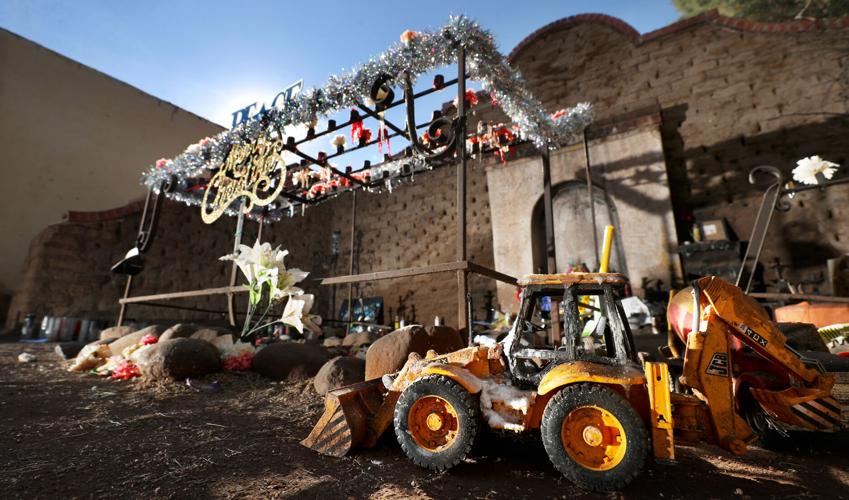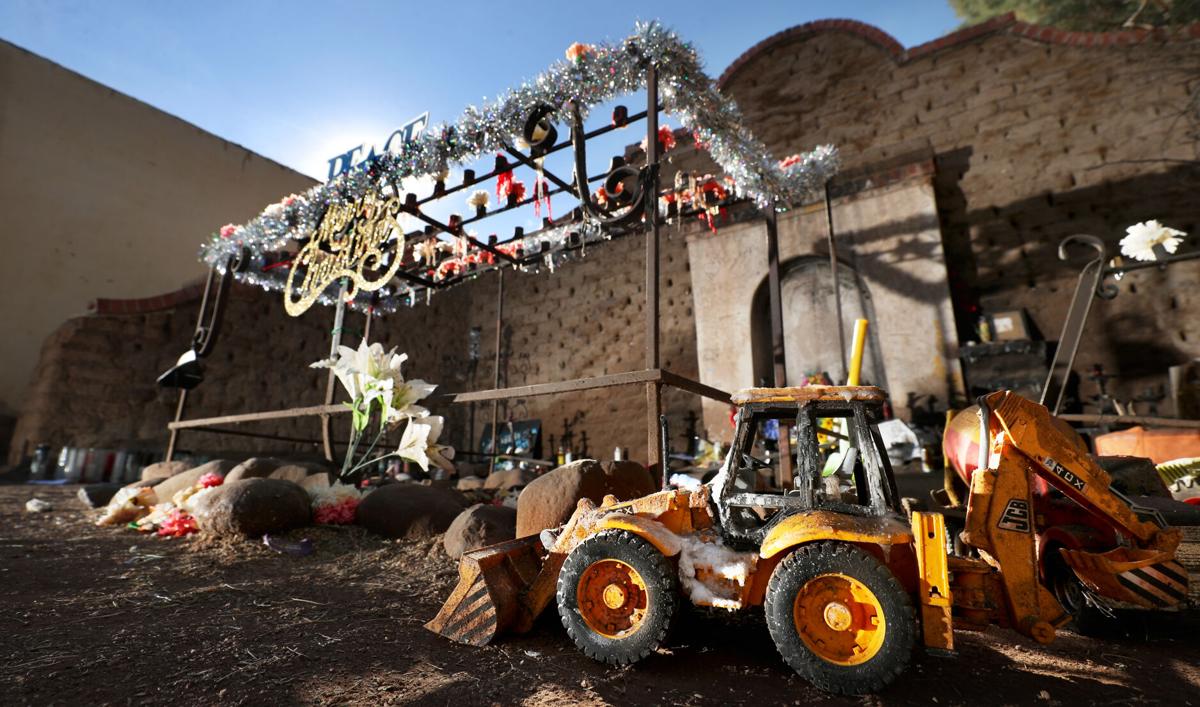A year ago, Miguel Reyes’ friend died. He printed some pictures at his local Walgreens and took them, along with some small candles, to El Tiradito shrine. He did the same for his father two years before.
“Feeling like you can connect with the dead, remembering them, it helps with the grief,” he said.
El Tiradito is a three-sided shrine of crumbling adobe walls, small and nondescript, mere streets away from the bustle and noise of downtown Tucson.
Tall glass candles, embellished with pictures of Catholic saints, crowd the ground in front of the arch, which is covered in painted and penned messages, such as one that says “I love you momma.”
Toy trucks, their paint faded, share space with broken porcelain figures, plastic flower wreaths and a photograph of a man holding a guitar — his features obscured by time and weather. Lying on its side in the dirt is a lone shot glass. “RIP Ruffles” is written on it in Sharpie.
Cultural identity
The shrine, at 420 S. Main Ave., has a long history in Tucson’s Barrio Viejo and has come to embody its cultural heritage.
The original was destroyed by a highway construction project but was later reestablished in 1927 on donated land, according to a 2007 article in the Arizona Journal of Hispanic Cultural Studies, “Barrio, Borderlands, and Beyond: Folk Religion and Universal Human Rights at Tucson’s El Tiradito Shrine.”
The article says that today’s adobe structure was actually built in 1940. In 1971, the shrine was again threatened by plans to cut through the neighborhood with a freeway, which would also have displaced almost 1,200 people.
Residents quickly formed a committee to oppose the decision. At the same time, activists successfully nominated El Tiradito to the National Register of Historic Places. Shortly after, the proposal was amended, and both El Tiradito and Barrio Viejo were preserved.
With age comes colorful stories, and El Tiradito doesn’t disappoint.
“Tiradito” is an affectionate Spanish diminutive for “thrown away one,” which refers to the local legend that a man is buried underneath the arch, according to a Tucson Parks and Recreation brochure. Several explanations exist, but most center on a man falling in love with a married woman and being murdered by her jealous husband.
Visitors to the shrine leave memoranda of relatives and friends who have passed, or write prayers and confessions on scraps of paper before tucking them in between bricks. Local legend says if your candle burns all night, your wish will come true.
Shrines like El Tiradito grow beyond their original narratives to allow people to personalize their individual grief in public but still deeply intimate ways, said Tom Beazley, who studies modern religious history at Arizona State University.
The shrine’s position in Barrio Viejo as a symbol of Mexican identity is also important, Reyes said. In the past, he has taken his teenage son and 6-year-old daughter to the shrine to light candles, connect with their heritage and introduce difficult conversations.
“It’s a way to make it easier to talk about death and to think about those who have died,” Reyes said.
Teresa Shaar grew up in Tucson and spent much of her childhood visiting the shrine with relatives or playmates. The story she heard was that a priest who had fallen in love was buried under the arch and that three other people were buried behind it.
“As a child, it was always very sacred to me,” Shaar said. “I was raised Catholic, and still when I drive by, I cross myself.”
Today, she owns El Minuto Cafe right next to the shrine.
Border deaths commemorated
Shrines also offer a place to grieve when traditional spaces aren’t available, such as for relatives who passed in another country, or for those who died in the desert of the borderlands.

People bring candles to a memorial for Carlos “Adrian” Ingram Lopez at El Tiradito shrine on June 25, 2020. Ingram Lopez died in police custody two months earlier.
For 17 years, migrant activist group Coalicion de Derechos Humanos held weekly vigils at El Tiradito to commemorate migrants who died crossing the border. The last vigil, according to the organization’s website, was held in 2017. Afterwards, the Latina activist group Promotoras Rompiendo Cadenas, with the YWCA, took on the responsibility.
Advocates for other social causes also raise awareness at El Tiradito. Sex workers are another group often left out of traditional memorialization spaces and for at least 17 years, the Sex Workers Outreach Program gathered at the site on Dec. 17, the International Day to End Violence against Sex Workers, to honor those whose lives were cut short by violence.

People bring candles to a memorial for Carlos “Adrian” Ingram Lopez at El Tiradito shrine on June 25, 2020. Ingram Lopez died in police custody two months earlier.
A tourist stop
Not everyone who visits the shrine does so to commemorate losses, however. A sign with the hours of operation marks it as a site open to the public, tourists and curiosity seekers alike.
A silver convertible recently pulled into the nearby cafe’s parking lot. A family of four crossed to the shrine and picked their way through the assortment of altars. They leaned together in front of the arch and snapped a group photo. Afterwards, they headed back to their car, on their way to different sights, having spent less than five minutes at El Tiradito.
A long blue line on the sidewalk just outside El Tiradito directs foot traffic to the shrine and toward other attractions.
Kelly Buechler followed that line and his mother-in-law’s directions from a walking tour of a Tucson brochure. She wanted the Portland native to get a “flavor of all the communities.”
Buechler was particularly interested in the shrine, because he’d heard so much about Day of the Dead. When asked what his impression of it was, he walked over to the shrine’s main area and spread his arms wide to encompass the candles, posters and assorted paraphernalia.
“I think it needs some cleaning up,” he said. “It looks burned up, and it seems to be some carryover from the Day of the Dead decorations.”
Jaime Cortes saw the shrine on a bike tour of Tucson and wanted to show his family. They’ve lived in Tucson for four years but are originally from Chile.
“It’s very impressive,” said Silvana Cortes.
Ultimately, shrines like El Tiradito exist at the intersection of public and private uses. Through them, visitors express their grief, preserve links to cultural heritage and claim a space to honor those who have died, known or unknown.
Still others arrive as observers, seeking to witness practices and beliefs different from their own.






